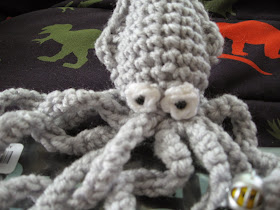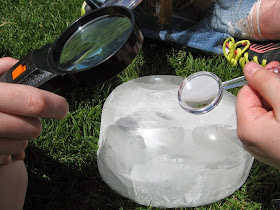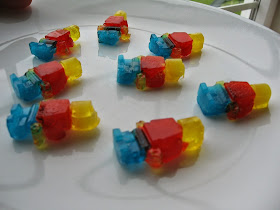Saturday, May 31, 2014
Summer Fun 2014 - Melting Ice With a Magnifying Glass
Once your children have finished roasting/burning all your marshmallows with a magnifying glass, and before they realize they have the power to catch the entire yard on fire...
...you might want to have an alternate, less hazardous, but still fascinating project on hand.
A large (large enough to stick around for a while in the summer heat) chunk of ice, does the trick nicely. Focusing tight beams of sunlight at the ice, will at first appear to be doing nothing, but after a few seconds, children will begin to hear the ice popping and cracking under the heat.
They might not be able to see the results of their work, but they will be able to feel the holes being formed. Move the magnifying glass, before you feel for holes. The focused beam of light burns fingers as easily as it melts ice.
Food coloring dropped on top of the ice, will puddle in the holes.
After a few minutes, a focused beam of light will start to melt deeply into the ice. The water in the hole will boil, and as the steam rises...
...and is cooled by the surrounding ice, it will form little smoke-like wisps of fog...
...which, we think, are pretty cool.
Friday, May 30, 2014
Building a Roman Arch Out of Cake
Before trying to build an arch out of ice...
...I prepped the children by showing them a video of a high school, in-class, arch building challenge.
Watching the teens puzzle out the problem got us ready to give it a try ourselves. The children suggested we buy a set of blocks like the ones they were using in the video. Actually, that particular block set has been on my wish list for a while, but I can never quite justify its expense for the amount of use I think it would get.
Even so, I found myself poised over the "Add to Cart" button on Amazon (this is not an affiliate link)...
...before coming to my senses and simply making a copy of the picture to enlarge, and cut out as template for making...
...a cake block version. Who doesn't like cake, right? I got a little carried away enlarging the picture, so we needed two cakes - even better.
We froze the cakes overnight, before cutting out our blocks, to make them harder, and easier to build with.
The girls insisted on adding frosting for mortar between the blocks. I didn't think it should be necessary, but it sounded like it might make for a tastier cake.
...until they added a final layer of frosting.
I'm not sure if it was the extra weight, the moisture from the frosting, or just that our cake blocks were beginning to thaw...
...but the frosted arch showed immediate structural stress, and then suffered a catastrophic collapse. It was very sad.
On the bright side though...
...there was cake.
It's great to be a homeschooler.
Thursday, May 29, 2014
Inspiring Summer Reading - Books and Homemade Toys - Giant Squid Edition
Teaching remedial reading to small groups of elementary, and middle school aged children, at a local private school this last year, has really got me thinking about the ways I've encouraged my own children to read, and enjoy reading.
All of my children have been pretty natural, though not all early, readers. They might not all read constantly, but when they do, whether it's for entertainment, or for information, it's with an enjoyment I didn't encounter in my students at the school.
So, over the course of the summer, I thought I'd share some of our homegrown strategies for encouraging a love of reading.
The first thing that comes to mind is that for the younger children especially, I often try to find ways to connect books to their interests of moment, whether it's through a snack, an activity, or as with the squid pictured at the top of this post - a toy, or more specifically, a homemade toy.
Actually, there's a story behind this particular toy, and since it demonstrates one of the ways we encourage reading - I'll share it.
Out of the blue, the other morning, D (age 11) called from his room, "Mom, how many tentacles does a
squid have?"
The answer is two, in case you were wondering, two extra long tentacles, and eight arms.
Naturally I was curious as to why he was asking. We've been in more of a Lego, and building phase lately, than into marine biology. It turned out he was building a Zoob squid to play with with his Lego men. That made sense.
I oohed and awed over D's Zoob creation, but pointed out that it might have been a little big in comparison to the Lego guys. Unfazed, D informed me it was a kraken. Needless to say, I was impressed (and my homeschooling heart swelled with joy - if not pride). It's been a few years since we read 20 Thousand Leagues Under the Sea, so I figured he probably picked the reference up from some video game, or cartoon, but even so - kraken - that's a pretty good word to be able to pull out of your hat. I knew I was going to have to make the most of it.
D went back to playing, and I started searching out a pattern for a quick, and easy squid toy. I found a simple, and free, which is always a bonus, crochet pattern from Crafty and Devious for just the sort of young kraken I was looking for. The pattern was what I wanted, because it was simple enough to make up quickly in the morning while the children were still sleeping. If you don't crochet, don't worry, the toy is the point, not how it was made.
 I modified it slightly to match our discussion by adding adding white crochet (5 sc into a magic ring) circles to go behind the eyes, because squid have very large eyes.
I modified it slightly to match our discussion by adding adding white crochet (5 sc into a magic ring) circles to go behind the eyes, because squid have very large eyes. And, I crocheted two extra long, additional arms, adding a sc, hdc, dc, slip stitch to the bottom, to form the tentacles, since D and I had specifically talked about those - besides which they are great for grabbing Lego men.
With my pattern picked, I slipped out to the library to see what they had for a book to go with it. I would have liked H.P. Newquist's Here There Be Monsters, The Legendary Kraken and the Giant Squid...
...but it was out, and besides which I think we've checked that one out before. I settled instead on Sandra Markle's Outside and Inside Giant Squid...
...which turned out to be just perfect, with a quick mention of the legends of the kraken, segueing nicely into a photo illustrated, simple, scientific text on the illusive giant squid - just right for an 11 year old.
Anyway, the next afternoon, with the book checked out, and the kraken crocheted, all I had to do was wait for a good opportunity, when D was occupied elsewhere, to sneak into his room, and set the scene.
At first, after he spotted his surprise he snatched up the toy, and ran off to play, leaving the book behind. I thought maybe my plan had backfired. That happens sometimes. But, it wasn't long before I spotted him totally engrossed it's pages.
The time I had put into the project (actually less time than it took to tell you about it) added a weight of value to the book. It wasn't just a book, but the promise of an adventure - one on which I wasn't his traveling companion, so much as the outfitter for the journey.
It's great to be a homeschooler.
Wednesday, May 28, 2014
Lego Movie Inspired Minifigure Twist-and-Match Tubes - Real World Math at Play
I decided it might be fun to make some Lego Movie inspired twist-and-match tubes, using printouts of minifigures copied from pictures of the Lego sets for sale on Amazon.

The idea is pretty much the same as the Polly Pocket type match ups we made a while back, except that the minifigures were easier to cut out.
Even so, as I was fiddling with measuring out strips of paper:
* to the proper length for fitting around empty cardboard tubes,
* and the proper width for each of the pieces of the Lego men,
* then dividing them out so the pieces were the correct distance apart, so that when twisted all three minifigures' heads, torsos, and legs would line up at the same time...
...it suddenly occurred to me, that it was exactly the real world sort of math problem I should be presenting to the children.
So, instead of making up the rest of the tubes, I left the supplies out for them, as a challenge to work out, on their own, while I was away at work for a few hours. I told them they could work together in teams, or on their own, and ask for them to jot down the sequence of steps, what worked and what didn't, so we could compare their different methods for solving the problem.
To my amazement, I came home to find finished, and functional toys, complete with how-to instructions from each child (minus T, who was at work himself, learning about real world math in another way). They might not have been arranged as neatly as I would have liked...
...and some of the how-tos were written out with a bit more haste, and with a few more spelling errors, than I preferred...
And now, we have a new set of toys I can enjoy playing with while the kids watch and re-watch The Lego Movie, this summer.
It's great to be a homeschooler.
Tuesday, May 27, 2014
Silicone Minifigure Ice-Cube Tray - Tricolor Gummy Men
After G's success creating chocolate Lego men, we decided to give multicolored gummy creations a try for our next round with our new silicone mold. If you're a regular reader here, I imagine you'll be seeing mini-men throughout the summer. Of course, almost any mold would work for this sort of thing - it wouldn't have to be minifigures.
At any rate, in order to be able to pour our homemade gummy solution into the molds without having all the colors mix together, we followed the steps we used last summer for gummy painting:
- Combine 6 and 1/4 Tablespoons of water, with 1 envelope of unflavored gelatin, and 2 tablespoons of regular (not sugar-free) flavored gelatin in a squeeze bottle, that can withstand being dipped into boiling water. One bottle for each flavor/color.
- Let the bottles sit for about 10 minutes, until the gummy solution is solid, and a little foamy.
- Carefully dip the bottles into hot (very hot) water, and stir the gummy solution until all the gelatin is completely dissolved.
- Place the bottles in the refrigerator for about 20 minutes, until the gummy solution is beginning to set up, but is still pourable.
With gummy filled bottles ready, we filled the bottom of the molds with a few drops of each color, being careful not to fill past the dividers.
Then, as our gummy continued to set up (remember a quick dip back into the hot water will liquify it again), we quickly filled in the rest of the mold.
Our men were a little lumpy on the back.
But, the finished product, removed from the mold after a few minutes in the freezer, looked pretty good.
Good enough to get the approval of my tasting crew, anyway. They were delighted with the gummies...
...and even more so, when I let them use the left-over solution in the bottles to paint out...
...more free-form creations...
...with the last remnants sticking to the sides of the bottles, being melted back down, and poured into the mold...
...for several sets of solid colored men.
Three bottles of gummy solution yielded 8 tricolor minifigures, 32 solid colored men, and three or four plates worth of crazy creations.
All in all, a pretty good bit of fun.
Monday, May 26, 2014
Ice Cube Roman Arch
Phyllis at All Things Beautiful posted a picture in one of her weekly reviews, that had me totally captivated. It was an arch built out of what looked to me like pieces of an egg carton. I followed the picture link back to homebirthmum, and discovered the arch, a project from Marti Ellen's Primary Physics, The Principles Behind Roman Machines, was made from plaster of Paris "ice" cubes.
Sadly, the book is not available at our local library, or any of my favorite online bookstores.
I bookmarked the project for a day when I'd have that much plaster of Paris on hand, and was preparing to move on, when it dawned on me...
...it's summer - or pretty much summer, anyway...
...and while we might be out of plaster of Paris...
...we have plenty of ice, some of it even in ice cube trays, like the ones called for in the project.
Real ice adds an element of urgency to building an arch, making it feel more like a game - and not school work sneaking into summer break.
Can you complete a standing structure before the ice melts?
We had some frozen tonic water cubes, too...
...which proved even easier to build with, and would have glowed in the dark...
...if our room had actually been dark. Looking at the pictures of that one later, I realized we left out the key stone in the center, which is why it had a gap near the top. Still, it was fun to build (not easy - but fun), and it stayed standing...
...so we're counting it as a summer success.



















































